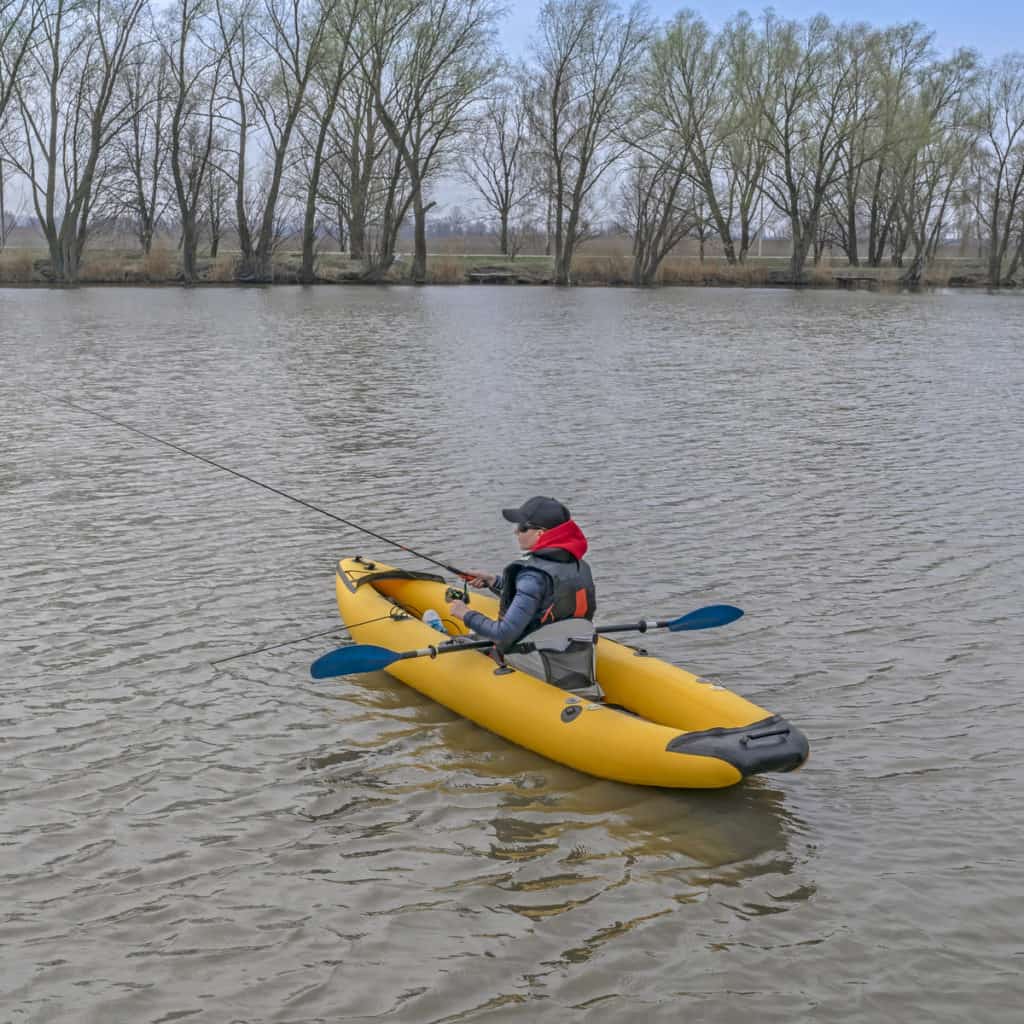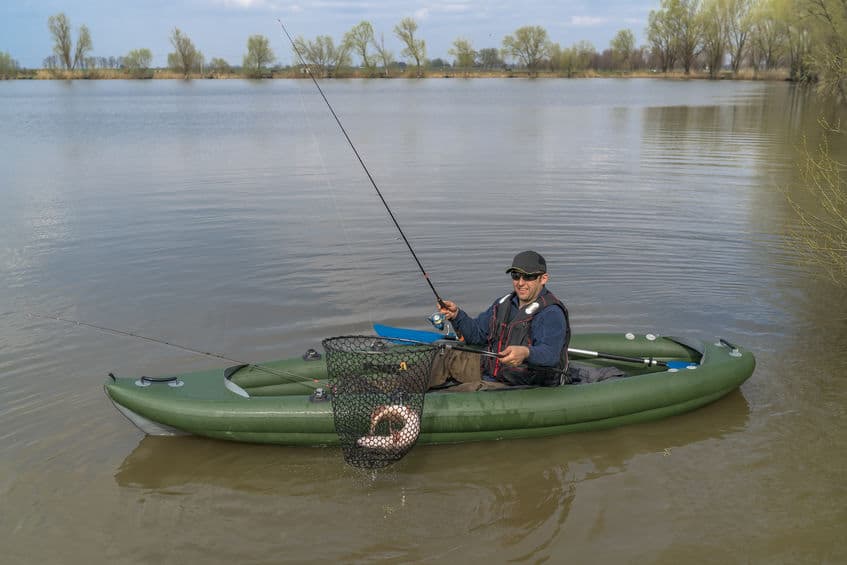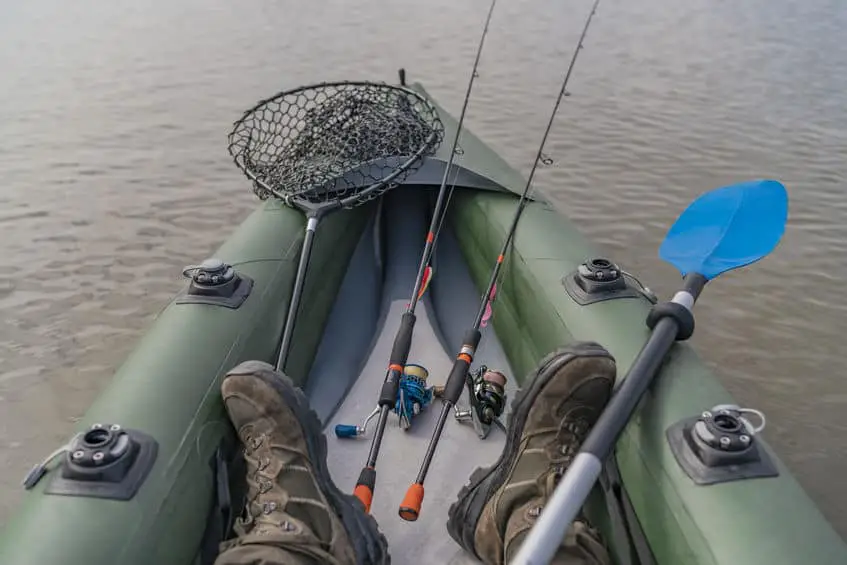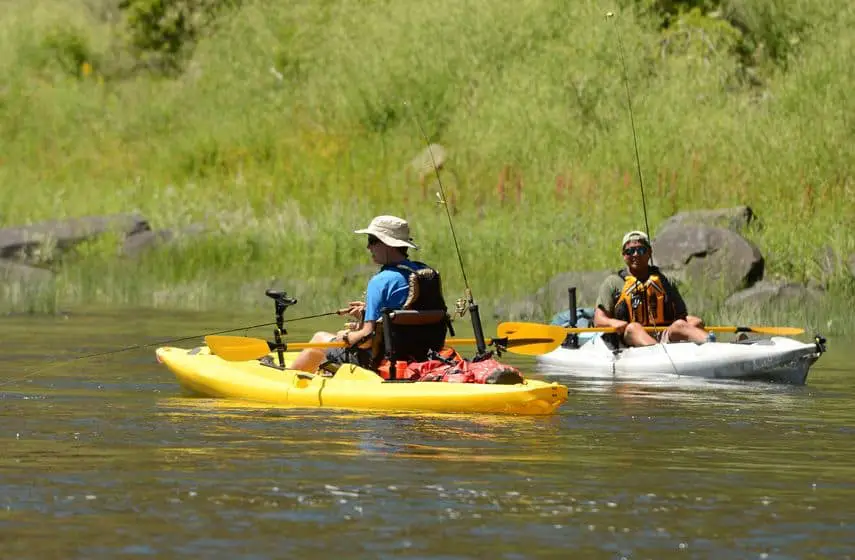When I bought my first fishing kayak (A 2017 Jackson Cuda) I had never even considered an inflatable alternative, mostly because I wasn’t aware that they existed. I decided to do some research on using inflatable kayaks for fishing in an attempt to learn something new.
The truth of the matter is that inflatable kayaks aren’t popular with kayak fisherman because quality ones cost as much as a hard plastic kayak. Compared to a polyethylene kayak, the inflatable kayak just doesn’t hold up unless you’re interested in ease of storage.
I’m not going to talk you into buying a hard kayak but instead here are my top fishing tips for inflatable kayaks.
Fishing is Easier From an Inflatable Fishing Kayak
When it comes to inflatable kayaks, there are five variants: Expedition, Lake and Flat Water, Recreational, Whitewater, and Fishing. The inflatable fishing kayak is designed with fishing in mind so it has many fisherman-friendly features that the other types lack.
While there are fishing specific inflatable kayaks, they still lack many quality features when compared to a hard plastic one. The lack of features come with the convenience that inflatable provides.
Here are some features that an inflatable fishing kayak comes with that are missing on other inflatable kayaks:
- Rod Holders
- Places to mount a fish finder and other gadgets
- Fishing specific gear storage
- An elevated seat
- Increased durability
With that being said, even inflatable kayaks produced for purposes other than fishing are still suitable for fishing, it’s just not ideal.

Purchasing an Inflatable Kayak For Fishing
Just like most industries, kayak fishing is no exception to the saying “you get what you pay for”. Inflatable kayaks are appealing to a lot of fishermen because of their low price point. Feature-rich kayaks that are made of high-quality materials aren’t cheap. Keep these tips in mind:
Demo, Demo, Demo!
There is no point spending several hundred dollars on something you don’t know if you like or not. Many of your local kayak dealers offer demo days where you can try out as many kayaks as you want. Don’t settle for an inflatable kayak that doesn’t meet your expectations. It may seem like a lot of work to travel and demo kayaks before buying them but is well worth it. I speak from experience here because I didn’t demo the first kayak I bought and I HATED it.
If you don’t have a kayak dealer close to you, you can join kayak fishing groups on Facebook. My favorite part about kayak fishing is the community that surrounds it. Generally, most groups are full of nice and experienced people willing to share their knowledge with you if you ask nicely. Some kayak fisherman may even meet up with you to let you try their rig out.
Key Characteristics and Features
Before you purchase an inflatable fishing kayak you want to make sure it has all the features you find necessary. Here are a few characteristics and features you may want your inflatable kayak to have.
- Rod holders
- Cup holders
- Fishfinder compatibility
- Stability
- Comfort
- Storage space or the ability to add it
Sit-in vs Sit-on-top
Traditionally, all kayaks where sit-in. The majority of inflatable kayaks are still manufactured as sit-in kayaks simply because the seat is also inflatable. Some models of sit-in inflatable kayaks allow for hard seats, which is nice because the sit-ins usually have more room to store gear than a sit-on-top.
The sit-on-top kayak is a fan favorite because it provides the angler with a broader range of motion. Casting, netting, and fighting a fish is a lot easier when you have room to move around. Sit-on-top kayaks also have an elevated seat which allows you to have a better line of sight, making it easier to spot fish that are hanging out in shallow areas.
There are a few hybrid models, which give you the best of both worlds. These inflatables are sit-in style rigged with a swivel seat that often sits up higher.
Solo or Tandem
If you’re looking to fish with a partner but stay in the same kayak together, then a tandem inflatable is for you. The benefit of tandem kayaking is obvious as it allows you and your partner to fish from the same vessel but the major downside is that they are often heavier, wider, and much slower. This isn’t a problem when the kayak has two anglers in it but is immediately noticeable when there is only one. If you plan on fishing alone from your inflatable kayak more often than not, do not purchase a tandem.
If you’re interested in trying to use a tandem kayak alone you can read more on that here: “The Golden Rule for Tandem Kayaking Alone“
Stability
Nobody wants to capsize their inflatable kayak, especially when fighting a large fish. The good news is that inflatable kayaks are generally very stable. The larger the pontoons are on the sides, the more stable your kayak will be. The design of the bottom of the kayak matters as well, a flat bottom is more stable but harder to paddle.
Price Point
After demoing several inflatable kayaks, checking them for features you desire, the last step is purchasing the kayak. It may seem tempting to buy a cheaper inflatable kayak to ‘test it out’ or ‘see if you like it’ but if you demo the kayak you really want and enjoy it there is no reason to do this.
If you buy a quality inflatable kayak it will last for years. In the end, it is cheaper to buy one expensive kayak than several cheap ones that only last the summer.
Rigging Your Inflatable Kayak For Fishing (And What ‘Rigging’ Means)

Fishing is and always will be about gear. Any fisherman knows that collecting fishing gear is part of the game. When it comes time to rig your inflatable kayak with fishing gear, you will soon find that space is extremely limited. What gear you rig your inflatable kayak with matters.
When you hear someone talk about ‘rigging’ a kayak for fishing they mean that they are adding equipment, gear, or accessories to their kayak to ready it. Rigging is often interchangeable with ‘set-up’.
When it comes down to the bare bones of inflatable kayak fishing there are three things you need: A PFD, a paddle, a rod, and tackle.
PFD (Personal Flotation Device)
Much like inflatable kayaks, PFDs come in all shapes and sizes with their own intended uses. A PFD specifically designed for kayak fishing will have many useful pockets along with multiple places to mount a knife. These vests have mesh backs and are vented for breathability. Higher-end PFDs are way more comfortable and worth the price tag. No matter what style of PFD you choose, JUST WEAR ONE!
Paddle
Any paddle can move you through the water but a high-quality double-sided paddle is the way to go. High-end paddles are lighter, perform better, and are more durable than a cheap one which makes long days on the water a lot easier. I recommend purchasing the best paddle you can afford.
Kayak fishing-specific paddles generally come with fisherman-friendly features:
- Hook retrieval slits cut into the blade of the paddle
- Engraved tape measure for measuring your catch
- Designed specifically for the kayak of a fisherman with bigger blades to push more water
Fishing Rod (Length Matters)
The quality of fishing rod you use isn’t a huge deal. Obviously, the more expensive rods will perform better under pressure and last longer. The main thing to keep in mind when selecting a rod to take onto an inflatable kayak is length.
When it comes to selecting the length of the rod to use on your inflatable kayak, there is no perfect answer. Rods that are about 7 feet long are easier to handle in tight spaces but a longer rod will make it easier to fight larger fish, provide better casting, and allow you to have more control over the fight.
Most kayak anglers carry several rods so they are ready for any situation.
Tackle (Most Importantly Tackle Storage)
A traditional tackle box/bag is more than suitable for inflatable kayak fishing. There are upgrades out there that make accessing tackle easier from your seat, though. Regardless of how you choose to store your tackle, make sure you tether it to your kayak just in case you find yourself going for a swim.
Advanced Rigging

Spend some time on your kayak to find out what kind of gear you need before spending hundreds of dollars on accessories. Kayak fishing is a booming industry and there are several companies pumping out high-quality products backed by engineering, it’s quite exciting.
Unfortunately, there aren’t as many rigging options for inflatable kayaks as there are for hard plastic ones. The reason is that inflatable kayaks deflate and require all equipment to be easily detached for storage. Here is some gear you may want to consider for your inflatable fishing kayak.
- A proper knife
- Fishfinder
- Bilge pump
- Repair kit
- Net
- Dry Bag
- Air pump
- Paddle leash
- Anchor
- Kayak crate
- Fish grips
If you’re interested in the gear that I use and recommend, you can check out my Recommended Gear Page.
DIY Rigging
DIY rigging is fun, innovative, and most importantly cost-effective. For the majority of name brand kayak gear, there is a cheap DIY alternative. You can simply do a Google search for anything you want following ‘DIY’ and go to town. The downsides of doing it yourself are:
- It looks cheap (If you care, that is)
- Can be time-consuming
Fishing Tips for an Inflatable Kayak
- Stay organized – Keeping your net in the same place every time you use it will save you a fish; Keeping your paddle in the same place every time you use it will save you a lot of hassle.
- Learn to cast one-handed – Kayak fishermen are always on the move. Your kayak will react to waves, wind, and current. Having your paddle in one hand and casting with the other is very common.
- Embrace the drift – let go and drift, you will catch way more fish. With all the factors acting against your kayak, it will not stay straight and that is okay. As long as you feel comfortable and aren’t drifting toward danger. You can dip the tip of your paddle into the water to slightly alter your trajectory.
- Use versatile lures – Using an easy-to-fish lure means that you’re able to attract a range of fish with one lure. Sometimes, catching different types of fish will help you pinpoint where they are hanging out and lead you to the catch you’re looking for.
- Carry several rods – most fishermen carry up to five rods on their kayaks. Each rod is rigged specifically for one lure or style of fishing. Having multiple rods ready to go at a moments notice will allow you save time instead of rigging your single rod a different way every time you want to change your approach.
How to Fish From an Inflatable Kayak Safely
I like to remain as safe as possible in everything I do and I think you should too. Fishing from an inflatable kayak comes with unique safety risks that you should remain aware of.
Punctures and Cuts
Inflatable kayaks are indeed inflatable, which means that they are more susceptible to punctures and cuts than hard plastic kayaks or any other fishing vessel for that matter. Obviously, you want to be extremely cautious when handling sharp equipment like a bait knife in or around your kayak but what most people forget about are transportation and storage.
Most of the time, damage to an inflatable kayak happens during transportation or storage. It is easy to snag your deflated kayak on a trunk latch or exposed nail head and not even notice. The best way to avoid damaging your inflatable kayak when storing or transporting it may be more simple than you think.
- When you are finished using your inflatable kayak, carefully drag it onto the bank or dock.
- Deflate your kayak correctly by following your owner’s manual
- Fold the kayak where it lays after deflating it
- Pack it away into a carrying bag or case before moving it, this adds an extra layer of fabric to help protect the kayak from snags and cuts you may not be aware of
- Vehicles have small vibrations that you may not be aware of so it is best to make sure kayak isn’t laying up against anything during transport, especially metal.
You can also transport you inflatable kayak inflated. If you choose to haul the kayak make sure that you let some air out of it so that a change in temperature or elevation won’t cause over inflation due to the pressure inside the kayak increasing.
Hooks, Fins, and Teeth
When fighting a fish, try your best to guide them away from your inflatable kayak at all costs. The bottoms of high-quality inflatable kayaks are designed to withstand scrapes from sharp rocks, limbs, and other debris but a hook is also made to puncture so it’s better to be safe than sorry.
Many inflatable kayak anglers also avoid the use of treble hooks.
As far as general kayak fishing safety goes, I wrote an article about it that you can read. The article includes tons of fun facts and covers all the bases. Read “Kayak Fishing is More Dangerous Than You Think, Here’s Why“
Wear the Proper Apparel

The sun is harsher on the water on the water during the summer and the frigid winter winds will cut right through you. Bringing the proper apparel can save you from wind chap, sunburn, hypothermia, bug bites and a plethora of other undesirable ailments. Here are a couple of apparel options you should consider before hitting the water in your inflatable fishing kayak.
Everyday/Hot weather
- Long-sleeve UV resistant shirt, usually made of polyester or nylon, short sleeve with sunscreen
- Long UV resistant pants or polyester shorts if you wear sunscreen
- A UV resistant hat/Boonie or buff
- Breathable footwear
- High-quality Polarized and UV resistant sunglasses (Costa or Oakley)
UV resistant clothing is important because it blocks harmful rays from the sun. Sunscreen is also effective at doing this but wears off and can be a hassle to apply.
Cold Weather
- A thin underwear layer that wicks sweat from your skin
- A middle insulating layer that retains heat
- An outer layer that protects you from the elements (wind, rain, and snow)
- Waterproof insulated boots and socks
- Waterproof gloves
- A thick toboggan/beanie and balaclava
The tricky part about kayak fishing in cold water is not staying dry but maintaining safe body temperature. In most cases, kayakers over-dress and cause themselves to overheat in cold climates.
I have a full run-down of everything you need to know about kayaking in cold climate. Read “Kayaking in Cold Weather, Stay Warm or Die”

